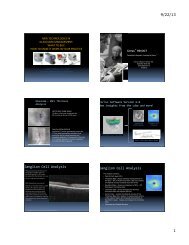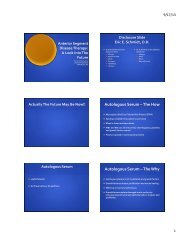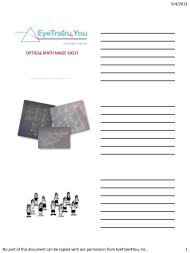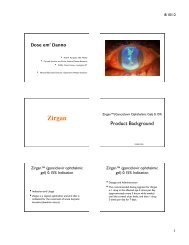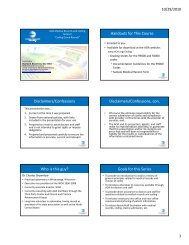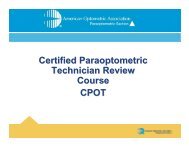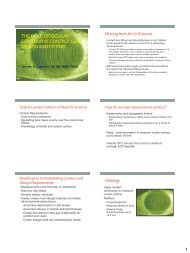Give Your Boomers a Boost: Update on Presbyopic Contact Lenses
Give Your Boomers a Boost: Update on Presbyopic Contact Lenses
Give Your Boomers a Boost: Update on Presbyopic Contact Lenses
You also want an ePaper? Increase the reach of your titles
YUMPU automatically turns print PDFs into web optimized ePapers that Google loves.
Modern Management of <strong>Presbyopic</strong> C<strong>on</strong>tact Lens PatientsThomas G. Quinn, OD, MS, FAAOI. PresbyopiaA. Populati<strong>on</strong> stats1. Over 1 in 4 patientsB. Predictable!1. First step to avoiding drop-out : inform the patient of what’s to comeII. Multifocals vs M<strong>on</strong>ovisi<strong>on</strong>: You’re the DeciderA. The Standard Paradigm1. push a little plus in n<strong>on</strong>-dominant eye to buy time2. push a little more plus the next year3. The result: M<strong>on</strong>ovisi<strong>on</strong>4. Multifocals as a late arrival problem-solverB. What the Studies Show1. Multifocals preferred over m<strong>on</strong>ovisi<strong>on</strong> approx 70% of time2. Most challenging: near visi<strong>on</strong> in low light* Situ, P et al, Successful M<strong>on</strong>ovisi<strong>on</strong> C<strong>on</strong>tact Lens Wearers Refitted with BifocalC<strong>on</strong>tact <strong>Lenses</strong>, Eye C<strong>on</strong>tact Lens, July 2003.* Richdale,K., Mitchell, GL and Zadnik,K Comparis<strong>on</strong> of Multifocal and M<strong>on</strong>ovisi<strong>on</strong>Soft C<strong>on</strong>tact Lens Correcti<strong>on</strong>s in Patients with Low-Astigmatic Presbyopia,Optom.Vis.Sci, 83(5):266-273, May 2006.* Johns<strong>on</strong> T et al, Multifocals vs M<strong>on</strong>ovisi<strong>on</strong>: A Comparative Study, CLAO, February2000* Rajagopalan et al Optom Vis Sci. 2006 Aug;83(8):611-5.C. The New Paradigm1. Start them in multifocals early2. Why haven’t we d<strong>on</strong>e this in the past?III. Presbyopia: New Rules of the Visi<strong>on</strong> GameA. Single Visi<strong>on</strong> Correcti<strong>on</strong>1. May get by with <strong>on</strong>e primary form of correcti<strong>on</strong>B. <strong>Presbyopic</strong> Visi<strong>on</strong> Correcti<strong>on</strong>1. May need multiple toolsa. multipurpose progressivesb. occupati<strong>on</strong>al lensesc. c<strong>on</strong>tact lensesd. added light source2. Goal: “To design c<strong>on</strong>tact lenses that will meet most of your needs mostof the time”C. The Expectati<strong>on</strong>s Game1. “The Sandwich Approach”a. positive statementb. the “meat” of the messagec. positive statementIV. Translating GP Multifocal Designsa. Desirable patient characteristicsi. Lower lid positi<strong>on</strong>1. tangent to limbus ideal2. above limbus acceptable
3. below limbus undesirableii. Detailed near demandsb. Fitting pearlsi. Placing seg height1. at least 50 percent pupil coverage in down gaze2. not sure? Bias highii. Enhancing lens translati<strong>on</strong>1. flatten base curve 0.50D2. increase prism 0.50Diii. Dealing with excessive lens rotati<strong>on</strong>1. flatten base curve 0.50D (if WTR <strong>on</strong>ly?)2. steepen base curve 0.50D if ATR3. increase prism 0.50D4. truncati<strong>on</strong>a. the upswept lower lid5. offset prism by 15 degreesiv. Solving the high riding lens1. flatten base curve 0.50D2. increase prism 0.50Dv. Assessing seg positi<strong>on</strong> and dynamics1. slitlamp2. ophthalmoscope3. subjective resp<strong>on</strong>sec. Dealing with the computeri. Computer glassesii. Trifocal designsiii. “seek the light”V. Toric Translating GP Multifocal C<strong>on</strong>tact <strong>Lenses</strong>a. Moderately toric cornea: c<strong>on</strong>sider aspheric designsb. Highly toric cornea: c<strong>on</strong>sider translating designi. Stability of fitii. Vertical translati<strong>on</strong> necessaryc. internal astigmatismi. correcting residual astigmatismd. Toric fit factorsi. SPE vs. CPE designVI. Aspheric Gas Permeable Multifocal DevelopmentsA. Prior limitati<strong>on</strong>s1. Translating designsa. lid positi<strong>on</strong>b. intermediate distance2. Aspheric designsa. near visi<strong>on</strong>B. Advancements in Manufacturing Optics1. Aspheric curvesa. back surfacei. prolate curve= center distanceii. oblate curve= center neariii. corneal topographic c<strong>on</strong>siderati<strong>on</strong>sb. fr<strong>on</strong>t surface
i. prolate curve= center nearii. oblate curve= center distanceiii. corneal topographic c<strong>on</strong>siderati<strong>on</strong>s2. Annular z<strong>on</strong>esa. center nearb. center distancec. c<strong>on</strong>trolling z<strong>on</strong>e size3. Combining design featuresC. Desired Patient Characteristics1. Dispositi<strong>on</strong>2. Ocular characteristicsVII. Hybrid Multifocal DesignsA. SynergEyes MF1. Distinct central, spherical add; various powersB. Duette MF1. Oxygen permeable materials2. Aspheric center near add optics; no add power selecti<strong>on</strong> neededa. large depth of fieldb. guard against over-minusingi. +1.50 fog testVIII. Soft Multifocal DevelopmentsA. Prior Limitati<strong>on</strong>sa. Compromise in distance visi<strong>on</strong>b. Finding balance between distance and nearB. Fitting Guide <str<strong>on</strong>g>Update</str<strong>on</strong>g>sa. PureVisi<strong>on</strong>/ Soflens MFb. Air Optix MFC. The Biofinity MFa. Based <strong>on</strong> design principles employed with Freq 55/ Proclear MFb. Optics “tweeked”c. Silic<strong>on</strong>e hydrogel materiald. Modified fitting guidei. Low adds, go “D” OUIX. Communicati<strong>on</strong>sA. <str<strong>on</strong>g>Your</str<strong>on</strong>g> attitude: empathetic, supportive, patientB. Take time to set patient attitude: The Sandwich ApproachX. Lens Selecti<strong>on</strong>A. Detailed refracti<strong>on</strong>1. No more minus than is absolutely necessary2. No more add than is absolutely necessaryB. Eye Dominance1. Sighting Dominance2. Sensory DominanceC. Follow the Fitting Guide1. Distance Rx: most plus power equivalent sphere2. Add: Follow the charts!
XI. Assessing PerformanceA. Scouting Report: release the patient from the exam room1. Open-ended questi<strong>on</strong>ingB. Real-world Envir<strong>on</strong>ment1. Lights up!2. Binocular c<strong>on</strong>diti<strong>on</strong>s3. Real world tasksXII. Enhancing PerformanceA. Knowing when to initiate change1. Symptom driven2. Just enough to get the job d<strong>on</strong>e3. The benefits of loose lensesB. Distance complaints: Follow the Fitting Guide!1. Usual need to improve visi<strong>on</strong> in dominant eye (m<strong>on</strong>ocular VA’s)2. If low add, probably modify distance Rx (usually add minus)3. If high add, probably decrease add power4. If distance complaints persist and less than 20/40 distance VA in n<strong>on</strong>dominanteye, use above strategies with n<strong>on</strong>-dominant eyeC. Near complaints: Follow the Fitting Guide!1. Usually need to improve visi<strong>on</strong> in n<strong>on</strong>-dominant eye (m<strong>on</strong>ocular VA’s)2. Push plus in distance <strong>on</strong> n<strong>on</strong>-dominant eye3. Increase add <strong>on</strong> n<strong>on</strong>-dominant eye4. If near complaints persist and less than 20/40 near VA in dominant eye,use above strategies with dominant eyeXIII. The Astigmatic PatientA. Corneal astigmatism matches vertexed spectacle cylinder1. GP Multifocal2. Hybrid MultifocalB. Internal astigmatism1. Toric Multifocal2. Toric M<strong>on</strong>ovisi<strong>on</strong>3. Toric Distance OU with readersXIV. Parting WordsA. To Patients1. “Light is your friend”2. “These lenses are designed to work together”3. “It’s a process”B. To You1. There is a need for MF c<strong>on</strong>tact lenses2. Be enthusiastic3. Communicate the benefits4. It’s about functi<strong>on</strong>ality



